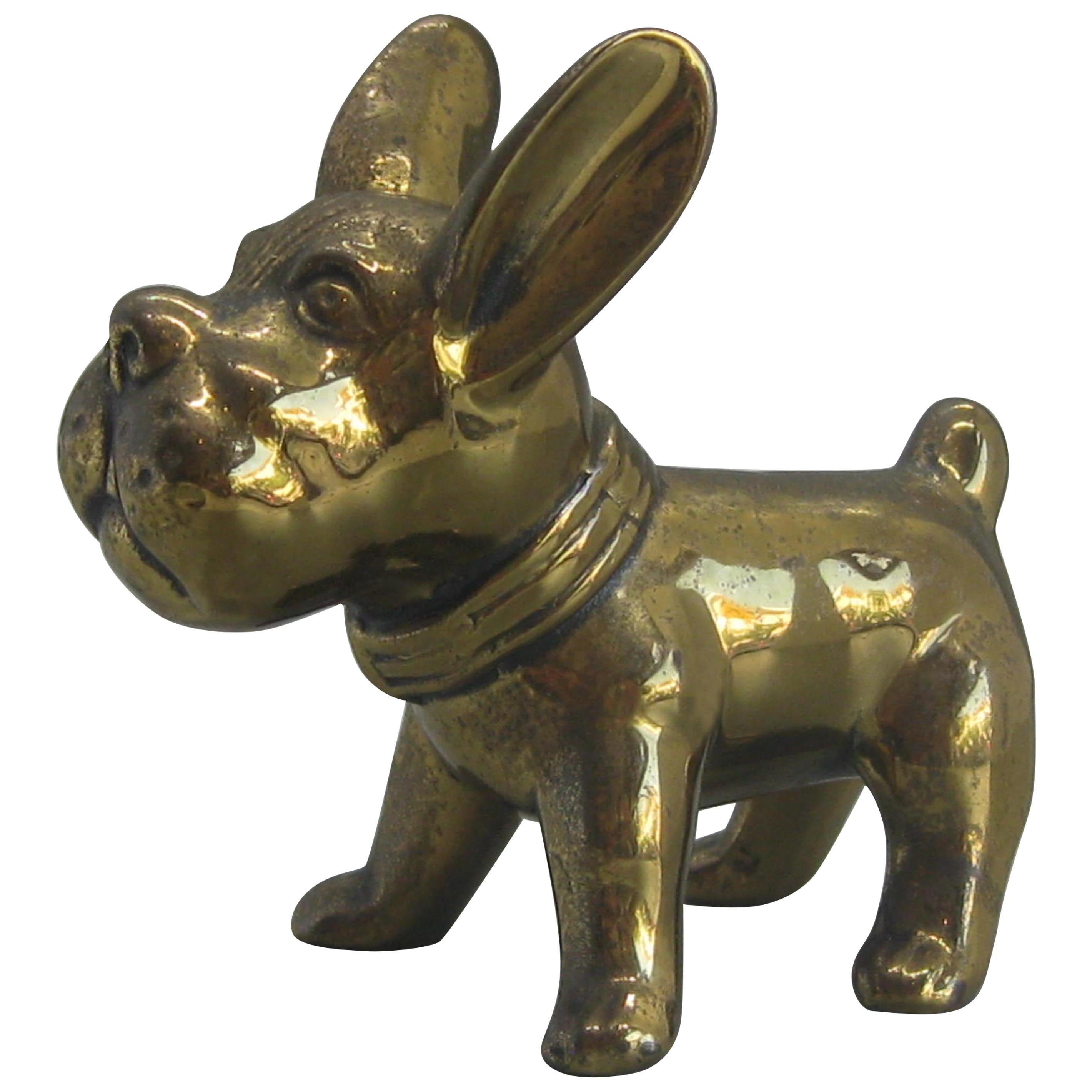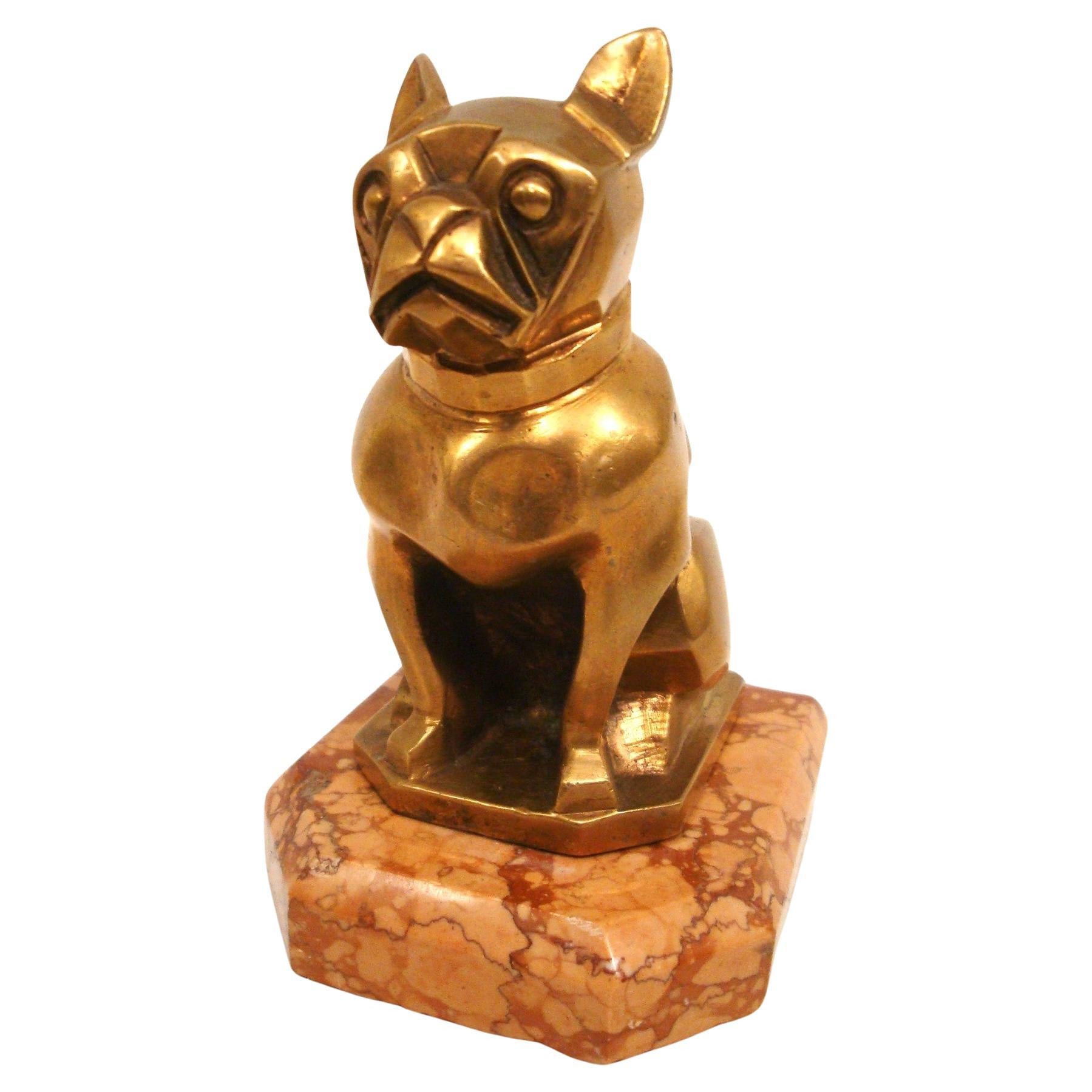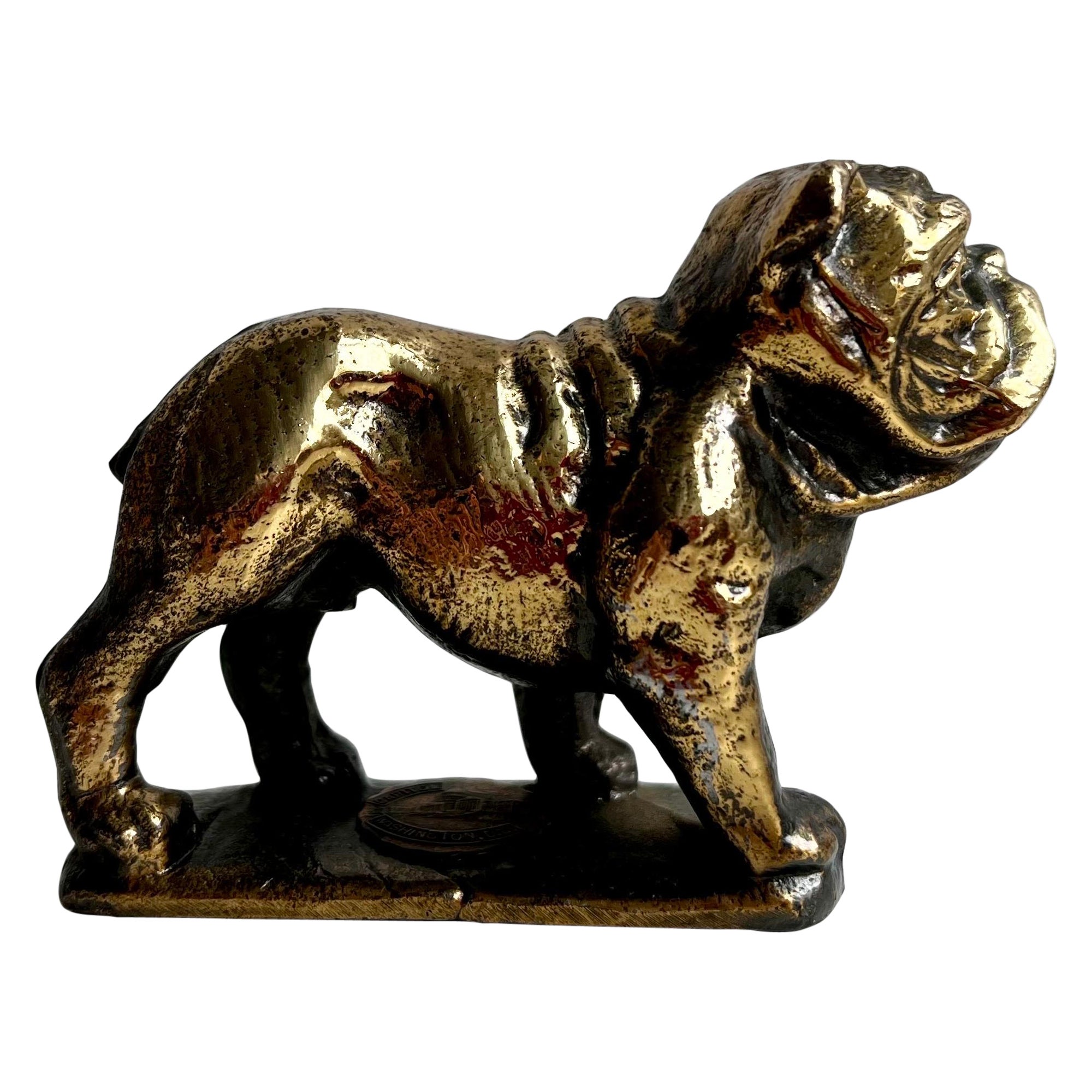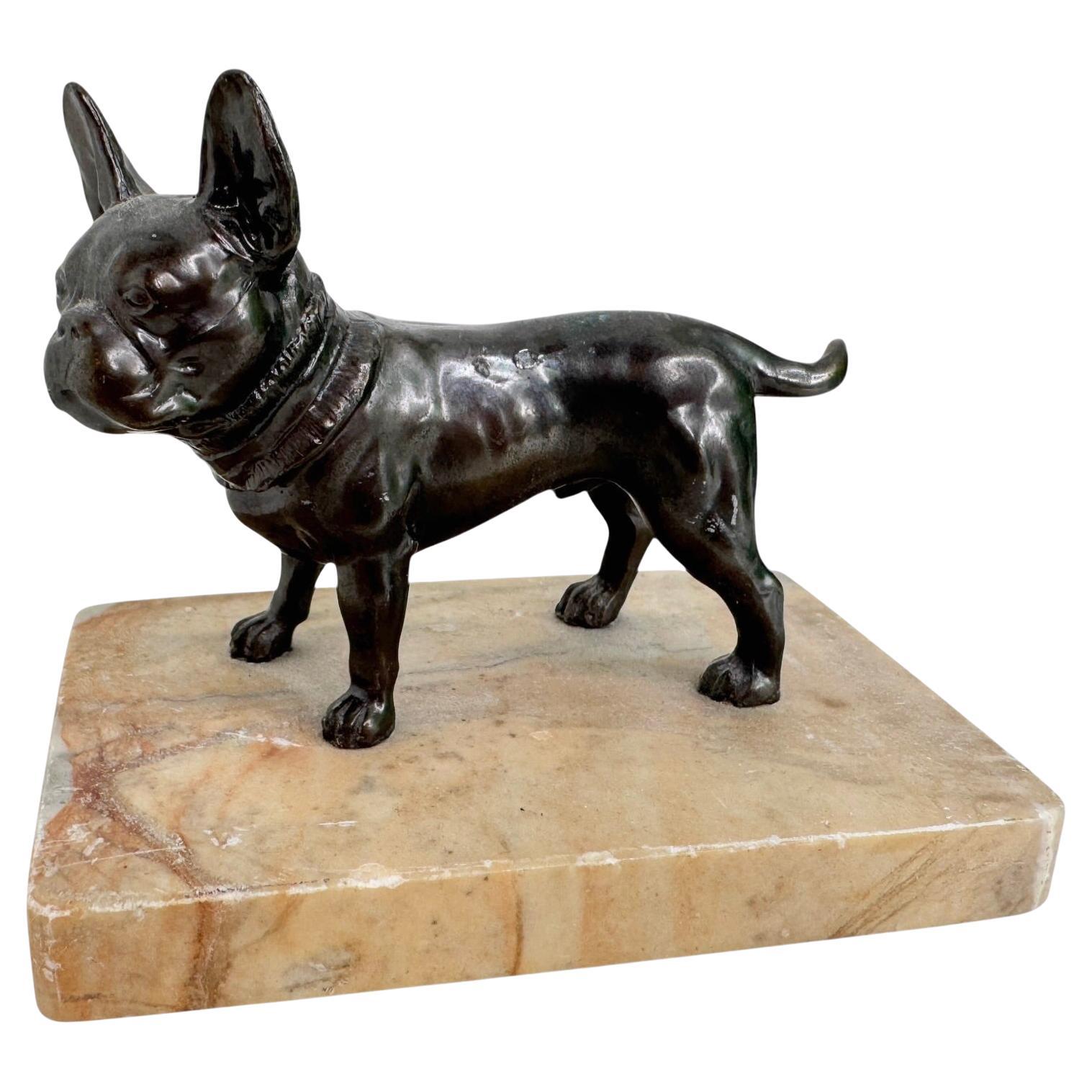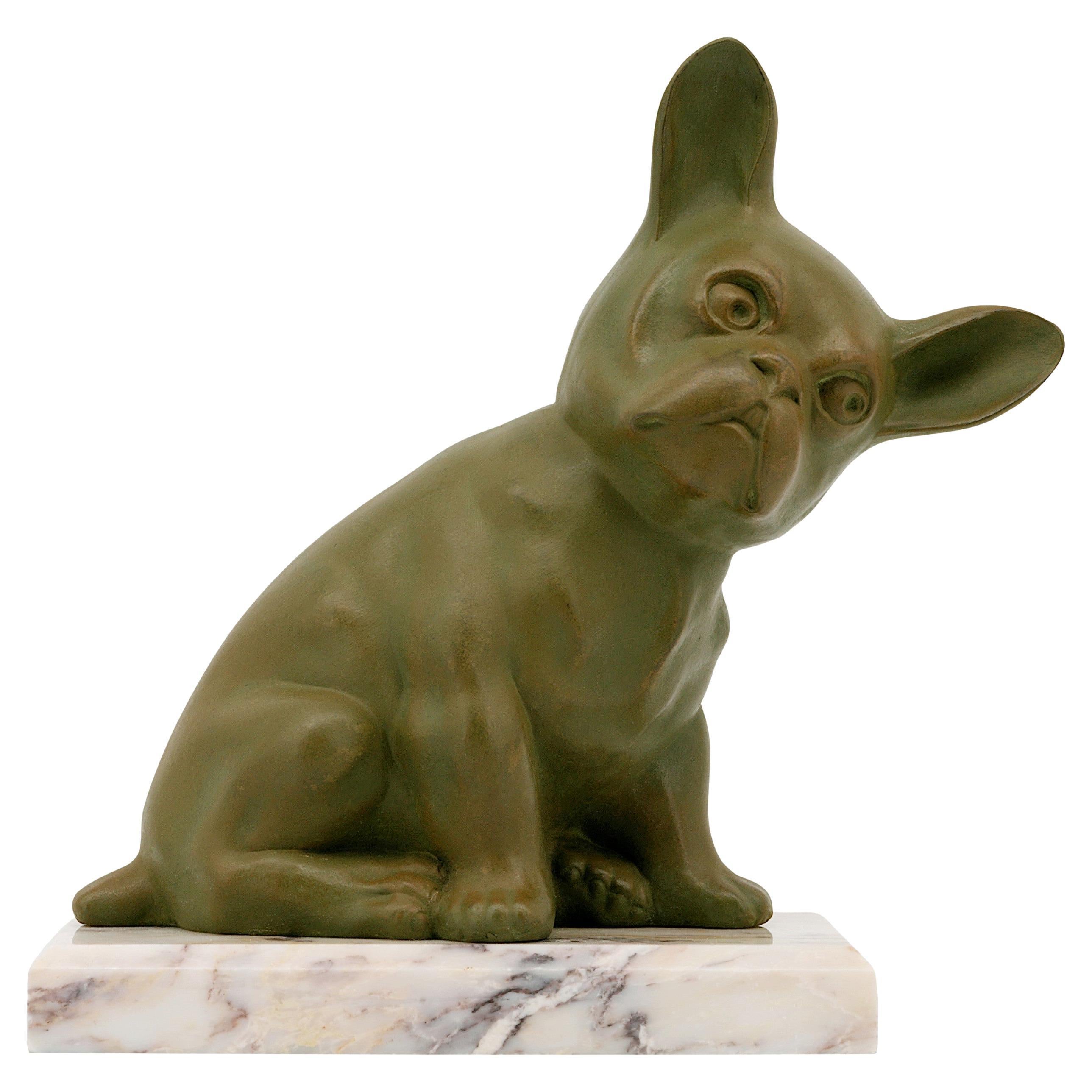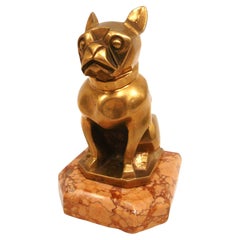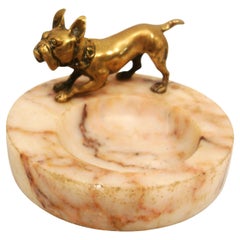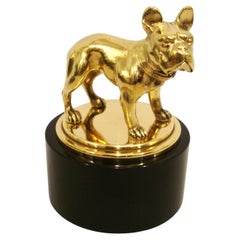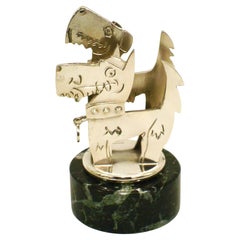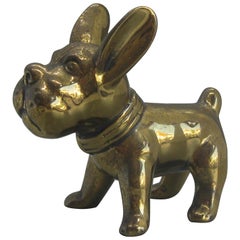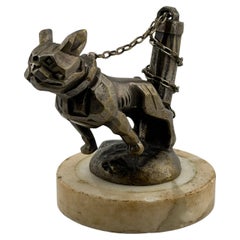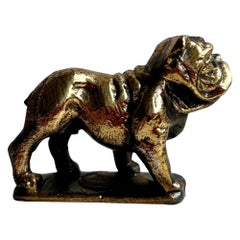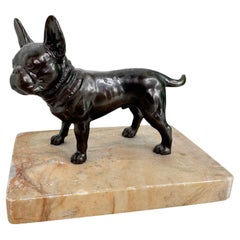Items Similar to Art Deco Car Mascot, Chained French Bulldog, Hood Ornament, France 1920s
Want more images or videos?
Request additional images or videos from the seller
1 of 10
Art Deco Car Mascot, Chained French Bulldog, Hood Ornament, France 1920s
$1,750
£1,337.97
€1,541.07
CA$2,452.29
A$2,737.75
CHF 1,434.54
MX$33,512.71
NOK 18,218.65
SEK 17,177.88
DKK 11,501.16
Shipping
Retrieving quote...The 1stDibs Promise:
Authenticity Guarantee,
Money-Back Guarantee,
24-Hour Cancellation
About the Item
Art Deco 'Chained Bulldog' Car Mascot / Hood Ornament designed by Marvel, French, 1920´s, silver-Gilt plated bronze, small version, 14cm long, complete with chain. Very nice desk piece of Automobilia.
Some info of similar dogs
Mascottes Passion, page 135, figure number 328a.
First Price on the expo of 1923 of the magazine L´Auto.
This piece from the designers Duges and Jouenne was presented by the art school Ecole Boulle.
We have specialized in the sale of Art Deco and Art Nouveau and Vintage styles since 1995. If you have any questions we are at your disposal. Pushing the button that reads 'View All From Seller'. And you can see more objects to the style for sale. Why are there so many antiques in Argentina?
In the 1880 – 1940 there was a grate wave of immigration encouraged by the periods of war that were taking place. 1st World War took place between 1914 and 1918 2nd World War took place between 1939 and 1945 The immigrants options were New York or Buenos Aires. Tickets were cheap and in Buenos Aires they were welcomed with open arms, as it was a country where everything was still to be done. Argentina was the country of new opportunities, labour was needed and religious freedom was assured, in many cases the of the family travel first until they were settled and then the rest of the family members join them. In the immigrant museum “Ellis Island Immigrant Building” in New York you can se the promotional posters of the boats that would take them to a new life. Between the years 1895 and 1896, Argentina had the highest DGP (gross domestic product) per capita in the world according to the Maddison Historical Statistics index, this situation arose due to the large amount of food being exported to European countries, which were at war. The Argentinean ships left the port of Buenos Aires with food, but they returned with furniture, clothes and construction elements, (it´s common to see this the old buildings of the historic neighbourhood of San Telmo, the beams with the inscription “Made in England)”, as well as many markets that were built in Buenos Aires, such us the San Telmo Market, whose structure was brought by ship and afterwards assembled in 900 Defensa Street. With the great influence of European immigrants living in the country, the children of the upper classes travelled to study in France, resulting in the inauguration of “La Maison Argentinienne”, on 27th of June 1928, in the international city of Paris, which hosted many Argentinians that were studying in Frace. It´s the fourth house to be built after France, Canada and Belgium, being the first Spanish-speaking one. Still in place today (17 Bd Jourdan, 75014, Paris, France). Many of the children of these wealthy families who attended international art exhibitions, museums and art courses abroad, took a keen interest in the European style. This is why Buenos Aires was at the time referred as “The Paris of South America”. Between the years 1890 and 1920 more than a hundred Palaces were built on Alvear Avenue the most exclusive avenue in Buenos Aires. Today some of these palaces have been transformed into museums, hotels and embassies. In the year 1936, the Kavanagh building was inaugurated, it was the tallest reinforced concrete building in South America. During 1994 the American Society of Civil Engineers distinguished it as an “international engineering milestone”, and it´s now considered a World Heritage of Modern Architecture. At the time was common to hire foreign architects such as Le Corbusier, who visited Buenos Aires/Argentina in 1929 and in 1948 he drew up the blueprints for a house built in La Plata City (which was declared a World Heritage Site). In 1947, the Hungarian architect Marcelo Breuer designed “Parador Ariston” in the seaside city of Mar del Plata. After an Argentinean student at Harvard University convinced him to come to Argentina. He worked on an urban development project in the Casa Amarilla, area of La Boca. The Ukrainian architect, Vladimiro Acosta, arrives in Argentina in 1928 and worked as an architect until que moved to Brazil. Antonio Bonet, a Spanish architect who worked with Le Corbusier in Paris, arrives in Argentina in 1937, where he carried out several architectural works and in 1938 designs the well-known BFK chair. Andres Kálnay, of Hungarian origin, made around 120 architectural masterpieces, among which the former Munich brewery stands out, he even made the furniture’s design. The German architect, Walter Gropius, director of the Bauhaus, lived in Argentina, where he wrote articles for “Sur” magazine and founded in Buenos Aires, an architectural firm with Franz Möller, who was also an architect, where he built two houses. At the same time several famous designers decided to immigrate to Argentina, among them we can find the well-known French designer, Jean-Michel Frank, who arrived in the country in 1940 and also worked for the Rockefeller family. Special pieces were made, which were sold exclusively in the country, such as the well-known German company “WMF”, who sold their products by catalogue, which were chosen by the ladies of high society in the list of wedding gifts, as well as the pieces designed by Christofle. The Swiss sculptor Alberto Giacometti, made special pieces for Argentinean mansions. In 1904 the first Jansen branch outside Paris was established in Buenos Aires, as the Argentinean clientele demanded a large amount of furniture, from the end of the 19th century to the mid-20th century. In 1970, the brand Rigolleau Argentina made pieces authorised by Lalique. The brands Maple and Thompson also set up shop in the country. The French plastic artist, Marcel Duchamp moved to Argentina in 1918-1919. Glass signed Gallé, Charder, Leverre, Schneider, Muller and other French firms. They were bought in flower shops and were given to ladies with beautiful floral arrangements. Some furniture manufacturers travelled to international fairs and bough the patterns to produce the furniture in Argentina, such as the furniture firm Englander and Bonta, who bought the patterns in Italy. It is worth mentioning that in Argentina we have the largest community of Italians outside of Italy, as it is estimated that 70 percent of the inhabitants have at least one Italian descendant, followed by Spanish immigrants. The most Important furniture stores in Argentina: Comte is founded in 1934 (under the direct management of Jean Michel Frank in 1940). Nordiska (Swedish company established in 1934). Churba in 1960, a company that brought foreign designers to present their furniture in the country: Denmark: (Arne Jacobsen, Finn Juhl, Bender Madsen, Ejner Larsen, Poul Kjaerholm, Hans Wegner) Sweden: (Hans Agne Jakobsson, Gustavsberg) United States: (Herman Miller) Finland: (Lisa Johansson, Folke Arstrom, Tapio Wirkkala, Alvar Aalto, Timo Sarpaneva) Swedish Factory: (Orrefors) Italy: (Littala, Vico Magistretti, Emma Gismondi, Gae Aulenti, Angelo Mangiarotti, Elio Martinelli, Gianna Celada, Angelo Mangiarotti, Mario Bellini, Carlo Scarpa) Finland: (Olivia Toikka) Plata Lappas (Lappas Silver): a goldsmith shop founded in 1887 in Argentina by Alcibiades Lappas of Greek origin. In 2019, in Argentina took place “the Art Deco world congress” . Argentina currently has more than 100 Art Deco buildings and another 90 Art Nouveau buildings throughout the city of Buenos Aires. Argentina is a country that has not been involved in many wars, which is why it has been a refuge for works of art and antiques from different periods of time, unlike European countries. That is way many collectors, museums and antique dealers from all over the world visit it, you should not miss the opportunity to visit this great country.
- Attributed to:Jouenne (Designer)Duges (Designer)
- Dimensions:Height: 5.91 in (15 cm)Width: 2.96 in (7.5 cm)Depth: 3.55 in (9 cm)
- Style:Art Deco (In the Style Of)
- Materials and Techniques:
- Place of Origin:
- Period:
- Date of Manufacture:1923
- Condition:Wear consistent with age and use.
- Seller Location:Buenos Aires, AR
- Reference Number:1stDibs: LU2027336785731
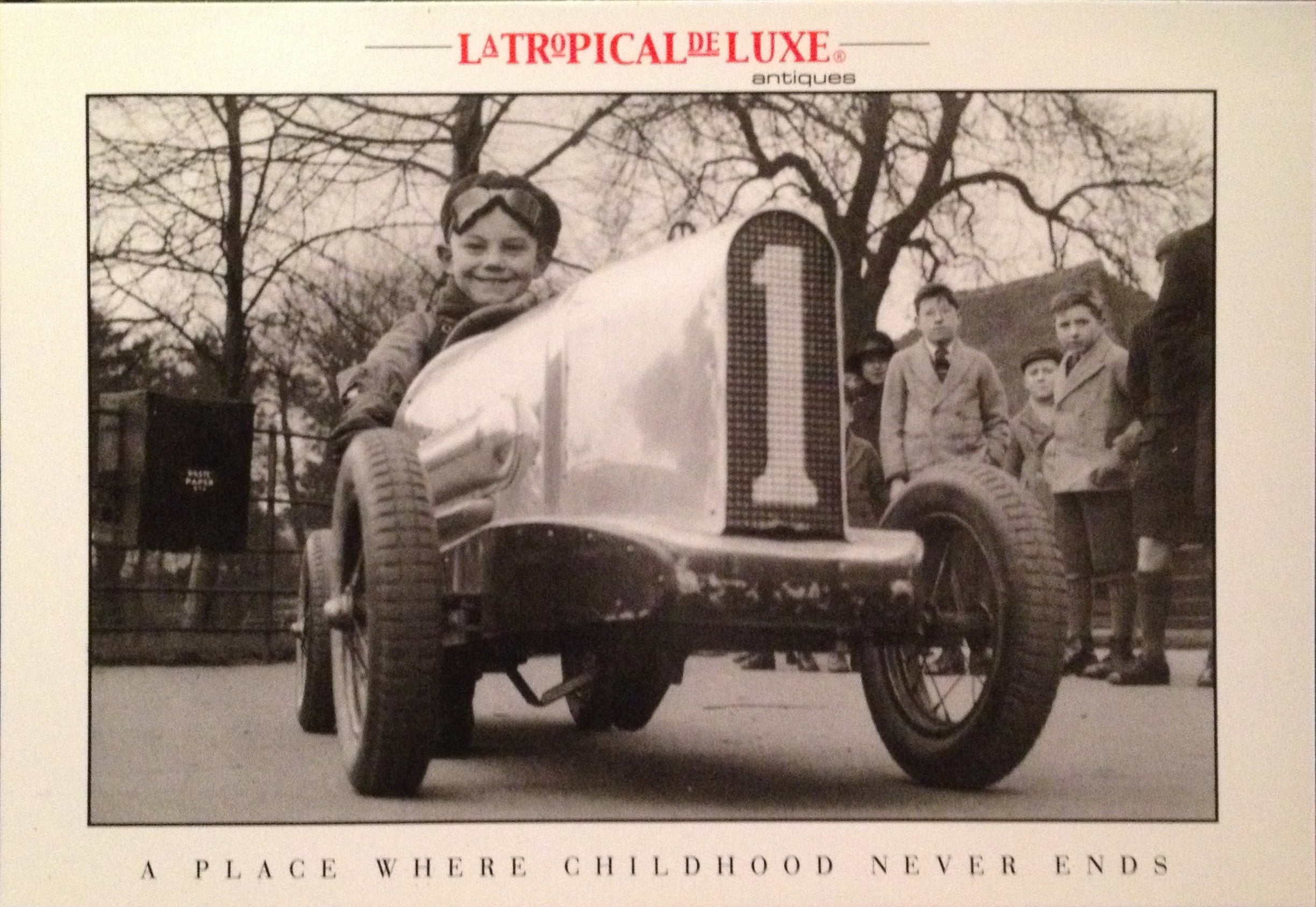
About the Seller
4.9
Vetted Professional Seller
Every seller passes strict standards for authenticity and reliability
Established in 2002
1stDibs seller since 2016
320 sales on 1stDibs
Typical response time: 1 hour
- ShippingRetrieving quote...Shipping from: San Telmo, Argentina
- Return Policy
Authenticity Guarantee
In the unlikely event there’s an issue with an item’s authenticity, contact us within 1 year for a full refund. DetailsMoney-Back Guarantee
If your item is not as described, is damaged in transit, or does not arrive, contact us within 7 days for a full refund. Details24-Hour Cancellation
You have a 24-hour grace period in which to reconsider your purchase, with no questions asked.Vetted Professional Sellers
Our world-class sellers must adhere to strict standards for service and quality, maintaining the integrity of our listings.Price-Match Guarantee
If you find that a seller listed the same item for a lower price elsewhere, we’ll match it.Trusted Global Delivery
Our best-in-class carrier network provides specialized shipping options worldwide, including custom delivery.More From This Seller
View AllArt Deco Sculpture of a French Bulldog Bookend or Paperweight, France, 1920s
Located in Buenos Aires, Olivos
Art Deco or Cubist Bronze sculpture of a French bulldog bookend or paperweight.
Made of bronze, mounted over a marble base.
Made in France, 19...
Category
Vintage 1920s French Art Deco Paperweights
Materials
Marble, Bronze
French Bulldog Bronze Desk Paperweight / Ashtray , Austria, 1920´s
Located in Buenos Aires, Olivos
French bulldog bronze figure / sculpture desk paperweight Ashtray - Austria 1920´s.
Marked Austria. Very nice conditions. Bronze is mounted over a marble base.
We have specialized i...
Category
Early 20th Century Austrian Art Deco Animal Sculptures
Materials
Marble, Bronze
French Bulldog Bronze Desk Paperweight, Austria, 1920´s
By Franz Bergmann
Located in Buenos Aires, Olivos
French bulldog bronze figure / sculpture desk paperweight - Austria 1920´s.
Very nice conditions. Bronze is mounted over a Belgian Black Marble base.
A statue of a bulldog standing on a black cylindrical base. The bulldog is depicted in a standing position with its head turned slightly to the right. The statue is highly polished, giving it a shiny and reflective surface. The black base contrasts with the gold statue, making the bulldog figure...
Category
Early 20th Century Austrian Art Deco Animal Sculptures
Materials
Belgian Black Marble, Bronze
$1,280 Sale Price
20% Off
Art Deco Hermès Paris "Ric et Rac" Dogs Car Mascot / Hood Ornament. Pol Rab 1920
By Hermès, Pol Rab
Located in Buenos Aires, Olivos
Art Deco Hermès Paris "Ric et Rac" Dogs Car Mascot / Hood Ornament. Pol Rab 1920´s.
Pol RAB (1898-1933) "Ric et Rac"
Car Mascot by Pol Rab, exclusive For Hermès, Circa 1920s. Marked "Hermès Paris" and artist signature Pol Rab. Inspired by the artist's cartoons published in the newspaper "Le Rire" at the end of the 20´s. Silvered bronze. Mounted on a marble base. The medals on the dog´s collars say Ric & Rac.
Perfect Gift for any vintage & antique car fan, any automobilia collector.
Car be used as a desk paperweight.
The Bronze hood ornament measures 10 cm aprox 10 inch. including the base it measures 13.5 cm.
Pol Rab – Creator of Ric and Rac...
Category
Early 20th Century French Art Deco Animal Sculptures
Materials
Marble, Bronze
$4,800 Sale Price
20% Off
"Running Dog" Packard Car Mascot, 1933. Automobilia
Located in Buenos Aires, Olivos
A "Running Dog" Packard Car Mascot / Hood Ornament , 1933, Automobilia
Detailed silhouette in silvered brass, 5 inches long, mounted over a lucite base. Si...
Category
Mid-20th Century American Art Deco Animal Sculptures
Materials
Brass
Big Silvered Bronze Vienna Dog Sculpture, Paperweight, 1900s
Located in Buenos Aires, Olivos
Big silvered bronze Vienna dog sculpture, 1900s. Very good detailed silvered bronze dog sculpture. Perfect as desk paperweight.
We have specialized in the ...
Category
Early 20th Century Austrian Art Nouveau Animal Sculptures
Materials
Bronze
You May Also Like
Antique Art Deco Jennings Brothers French Bulldog Dog Figural Brass Sculpture
By Jennings Bros.
Located in San Diego, CA
Antique hollow cast brass Art Deco French Bulldog figurine/sculpture made by Jennings brothers, circa 1920s-1930s. Signed on the bottom with the makers mark "JB". Great patina and co...
Category
Early 20th Century American Animal Sculptures
Materials
Brass
French Bulldog On Chain/Marvel Hood Figurine/Art Deco/1920's/Marble Stand
Located in Bernardsville, NJ
This beautiful collectible piece dates back to the roaring twenties. In 1922 this figurine won first price in the Salon De L'Auto in Paris. It is set in a marble stand.
Dimensions: ...
Category
Vintage 1920s Figurines and Sculptures
Small "French" Bulldog Statue or Paperweight
Located in Philadelphia, PA
Small "French" Bulldog Statue
"can also be used as a paperweight"
" has a round stamp on the top of the base which says
Washington DC - possible Jack the Bulldog the official mas...
Category
Mid-20th Century American Mid-Century Modern Animal Sculptures
Materials
Metal
Early 20th Century Pug Dog Austrian Miniature Figurine Statue 1910s Austria
Located in Nuernberg, DE
Classic early 1910s metal (bronze) figurine. Shows a beautiful pug dog. Found at an estate sale in Vienna, Austria. It's fixed on a marble base. This one is singed with a signature a...
Category
Vintage 1910s German Art Nouveau Animal Sculptures
Materials
Marble, Metal
Bulldog Sculpture, 1920
Located in Saint-Amans-des-Cots, FR
French Art Deco French Bulldog Sculpture, France, ca. 1920. This charming French Art Deco sculpture, created around 1925, depicts a French Bulldog in a stylized and elegant manner. M...
Category
Vintage 1920s French Art Deco Animal Sculptures
Materials
Marble, Spelter
$4,800
Antique Cold Painted Vienna French Bulldog, Bergman Style
By Bergmann Foundry
Located in Petaluma, CA
This terrier is remarkably detailed and richly hand painted. One of the nicer examples you will find. While unsigned, we believe it was done by the Bergmann Foundry. It is nice size ...
Category
Early 20th Century Austrian Other Animal Sculptures
Materials
Bronze
$647 Sale Price
34% Off
More Ways To Browse
French Goldsmith
French Antique Company
1920s French Posters
French Embassy
Travel Poster 1920s
French Country Island
French Food Posters
1890s French Posters
Vintage French Poster Food
French Canadian Antique
Small Silver Animals
French Old Paris Plates
1920s Gold Chain
German Antique Ornaments
Antique South American Sculpture
Antique Desk Ornaments
Children Cars
Hood Ornament
